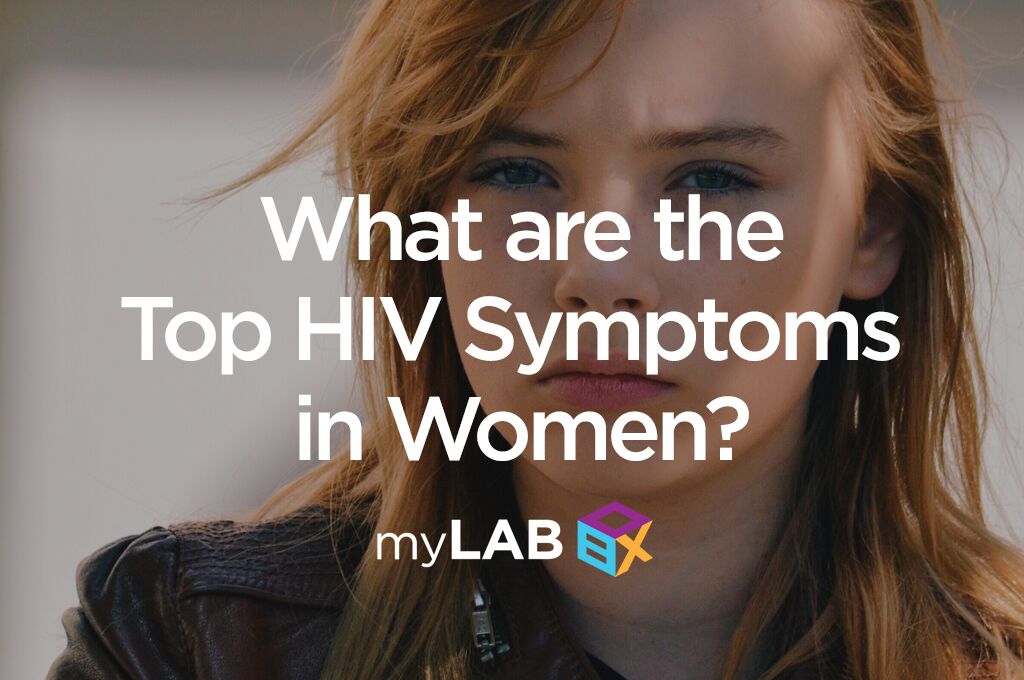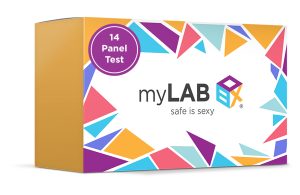Common HIV Symptoms in Women

| ❖ Free physician consultation ❖ Mail-in kits for home use ❖ Test in just 5 minutes ❖ Lab results in 2-5 days ❖ 100% pain free ❖ Enjoy free shipping |
Over one million Americans are living with HIV.[1] Not only that, but HIV can affect anyone, regardless of race, gender, or sexual orientation. With that said, women accounted for 19% of all HIV diagnoses in the United States.[1]
It is important to recognize early HIV symptoms in women. The earlier you get tested and can begin treatment, the better. HIV (human immunodeficiency virus) is an incurable virus that weakens your immune system and is spread through some bodily fluids like semen and blood. HIV can also spread from mother to child during pregnancy, birth, or breastfeeding. When left untreated, it can cause health complications and develop into AIDS (acquired immunodeficiency syndrome), a disease that leaves you at risk of getting an increasing number of severe illnesses.
Common HIV/AIDS Symptoms in Women
There are also some specific HIV symptoms in women that would not affect men, including:
- Increased frequency of vaginal yeast infections
- Abnormal menstrual cycles
- Severe pelvic inflammatory disease (PID)
- An increased risk of cervical cancer
- A pregnant woman may potentially pass HIV on to her baby
ORDER YOUR KIT NOW & TEST AT HOME!
See also: HIV symptoms in men
How Does HIV Affect Pregnancy?
For women that are pregnant, HIV can cause other complications. The virus can be transmitted from a mother to her child during childbirth. This can also happen while breastfeeding. The risk of transmission from mother to child can lessen through careful treatment during pregnancy,[2] but only if the woman is aware that the virus is present.[3]
Early HIV Symptoms in Women
According to the CDC, 87% of HIV diagnoses in women are due to heterosexual sex with someone who was infected with the virus. The other 13% of infections were due to intravenous drug use. Now you know a bit more about the three stages of HIV that affect men and women. Let’s talk about the early HIV Symptoms in women.
Common Symptoms in Both Men and Women
In general, the HIV infection follows a similar pattern in men and women. These often show in three stages:[4]
- Acute illness: This may or may not occur. If it does, it will usually occur soon after exposure to the infection.
- Asymptomatic period: This is a significantly longer phase. Like the name says, HIV carriers will not experience any symptoms. This period of time can last ten years or more.
- Advanced infection: In this late phase of infection, carriers will experience a highly weakened immune system. This is the stage that makes you susceptible to a number of other illnesses that are tougher for HIV to combat.
Phase 1: Acute Illness
It may take a couple of weeks for HIV Symptoms in Women to become visible during this initial phase. For 80% of infected people, the first symptoms appear within two-to-four weeks and often resemble the flu.[5]
These symptoms may include:
- body rash
- fever
- sore throat
- severe headaches
- fatigue
- swollen lymph nodes
- ulcers in the mouth or on the genitals
- muscle aches and joint pain
- vaginal infections, such as yeast infections and bacterial vaginosis
- nausea and vomiting
- night sweats
Of course, that’s assuming the symptoms are even visible at all. Many people with HIV may not see symptoms for several years. The only way to truly know for sure whether or not you have HIV is to get tested.
Phase 2: Asymptomatic Period
Once the first phase ends, the initial symptoms will completely disappear. During this seemingly dormant stage, the virus is actually replicating within your body. Though you don’t feel sick, the virus is still actively weakening your immune system.
This deceptive nature of HIV is a key reason why regular STD testing is imperative.
Phase 3: Advanced Infection
During the last stage of the infection, your immune system is severely damaged. Standard “run of the mill” illnesses can now become life threatening. With a weakened immune system, you may notice that you frequently get colds, flus, and fungal infections and have a harder time fighting them off.
If you’ve detected the infection by this point, treatment will greatly improve your ability to live a normal lifestyle.[6]
During this stage, you might experience the following AIDS symptoms:
- nausea
- vomiting
- diarrhea
- fatigue
- rapid weight loss
- shortness of breath
- fever
- chills
- night sweats
- rashes, sores, or lesions
- swelling of the lymph nodes in the armpits, groin, or neck
- memory loss, confusion, or neurological disorders
In addition, HIV poses a greater risk for women who are pregnant. In these cases, HIV can cause other complications. For instance, the virus may be passed onto a pregnant woman’s unborn child. An infected mother can also spread HIV to her baby through breastfeeding. With treatment, these risks can be minimized or eliminated. To be clear, an HIV-positive woman can still give birth to a healthy HIV-negative child with the proper treatment prior to delivery.
HIV and Preventive Treatment
Using a condom during any sex act should be your first line of defense against HIV and other sexually transmitted infections and diseases. As we all know, condoms aren’t perfect. Fortunately, if you are HIV negative, a daily Pre-exposure prophylaxis (PreP) pill is another way to prevent the spread of HIV. When taken properly, this pill can significantly reduce your risk of contracting HIV. Often, it is taken by people who are in a relationship with someone who is HIV-positive or at high risk of contracting HIV. You can learn more about PrEP and HIV in our previous article on the topic.
More Information About HIV:
What is HIV?
HIV stands for human immunodeficiency virus. This is the infamous virus that can lead to acquired immunodeficiency syndrome, or AIDS. HIV attacks the body’s immune system, damaging the carrier’s ability to fight off infections.[7] This infection can be passed from person to person through contact with infected bodily fluids. This includes blood, semen, and vaginal fluids.
A common cause of the virus is unprotected sex with an infected partner. According to the CDC, 87% of HIV diagnoses in women were attributed to heterosexual sex. The other 13% were attributed to intravenous drug use.[1]
Unlike other viruses, the human body cannot fully get rid of HIV. This means that once you have HIV, you have it for life. Fortunately, with proper treatment and medical care, HIV can be monitored and controlled so that those who have the virus can live a happy and healthy life. This requires that they are vigilant about their symptoms and treatments.
The Best Prevention
Using a condom during any sex act isn’t foolproof, but it can seriously reduce the possibility of contracting or spreading STDs and HIV.[8][9]
Getting tested is the only way to know whether or not you have HIV. The CDC recommends that all adults, from ages 13 to 64, should be screened for the virus.[10] You can order an at-home HIV testing package from myLAB Box. These tests offer lab-certified results that can be checked discreetly online.
See also: Safe is Sexy: Guide to HIV Testing
There isn’t a cure for HIV; however, getting treatment early can slow the progression of the disease and significantly improve quality of life. A recent study found that people with HIV might have a near-normal life expectancy,[6] as long as they begin treatment before their immune systems are too severely damaged.
Get Tested for HIV Early
If early HIV symptoms in women are present, just like in men, it is a good idea to get tested right away. However, it is important to remember that HIV does not always show signs or symptoms. If you are sexually active, you should be tested regardless. Luckily, there is an easy and convenient way to test from home! Here’s how it works:
- Order: Order your HIV test online. It will arrive in 1-3 days in a discreet package. You may want to consider a combination panel kit, which allows you to screen for multiple infections at once. These include the 5-panel Safe Box, 8-panel Uber Box, the Love Box for you and your partner to test together, and the comprehensive 14-panel Total Box.
- Test: It only takes about 5 minutes to use your test. This can be done at any time and from any place.
- Return: Send your sample back to the lab. We even provide a pre-paid addressed return envelope.
- Get Results. Your lab-certified results will soon be available online!
Now you can better recognize early HIV symptoms in women and men. This will better prepare you to identify any problematic health signs you may experience. That said, the best thing you can do for your sexual health is to get tested. It’s the only way to know for sure that you know your status! Don’t stress, just test.
Reviewed by Luis Ferdinand M. Papa, MD, MHA
References
- [1]The CDC’s report from 2015 found one million Americans were infected. Of those one million, 19% were women. Heterosexual contact accounted for 87% of HIV diagnoses among women. Injection drug use accounted for 12%.
HIV among women . Centers for Disease Control and Prevention July 2018.
- [2]Pregnant women with HIV receive HIV medicines during pregnancy and childbirth to prevent mother-to-child transmission of HIV.
Preventing Mother-to-Child Transmission of HIV. National Institutes of Health. May 2018.
- [3]Study found that the perinatal HIV transmission rate was 20% when the mother did not receive any prenatal therapy. HAART (highly active antiretroviral therapy) reduced the HIV transmission rate to 1.2%.
Ellen R. Cooper, Manhattan Charurat, Lynne Mofenson, et al. Combination Antiretroviral Strategies for the Treatment of Pregnant HIV-1–Infected Women and Prevention of Perinatal HIV-1 Transmission. Journal of Acquired Immune Deficiency Syndromes 2002.
- [4]When people get HIV and don’t receive treatment, they will typically progress through three stages of disease.
About HIV/AIDS. Centers for Disease Control and Prevention. October 2018.
- [5]A total of 72 (80%) patients had signs or symptoms associated with Acute HIV Infection that occurred within 2 weeks before undergoing testing.
Hoenigl M, Green N, Camacho M. Signs or Symptoms of Acute HIV Infection in a Cohort Undergoing Community-Based Screening. Emerging Infectious Diseases2016.
- [6]A study examined changes in 3 year survival and life expectancy of patients starting combination antiretroviral therapy between 1996 and 2013.
The Antiretroviral Therapy Cohort Collaboration. Survival of HIV-positive patients starting antiretroviral therapy between 1996 and 2013: a collaborative analysis of cohort studies. The Lancet. May 2017.
- [7]The gastrointestinal (GI) tract is a major site of HIV replication. It is also the main structural and immunological barrier against bacteria from outside the body. HIV infection attacks the cells that form this mucosal barrier, resulting in a compromised immune system.
Brenchley JM, Douek DC. HIV infection and the gastrointestinal immune system. Mucosal Immunology. December 2007
- [8]Accumulated data on condom use and HIV infection revealed that consistent use of male condoms protect against HIV acquisition (50% to 100%).
Cates W. How much do condoms protect against sexually transmitted diseases?. IPPF Medical Bulletin 1997.
- [9]Review determined that consistent condom use for all intercourse decreased HIV seroconversion (transmission) by 80% but did not completely eliminate transmission.
Susan C Weller, Karen Davis‐Beaty. Condom effectiveness in reducing heterosexual HIV transmission. Cochrane Systematic Review. January 2002.
- [10]CDC recommends that everyone between the ages of 13 and 64 get tested for HIV at least once as part of routine health care.
Testing. Cochrane Systematic Review. October 2018.
Popular Tests

Total Box
14 Panel STD Test
In Stock – Free Shipping
$369 – $399
